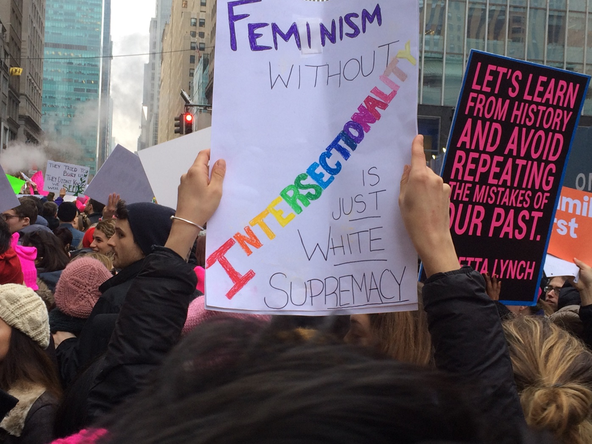What is intersectionality?
by Professor Ann Phoenix FBA
8 Mar 2018
Intersectionality, a burgeoning, multidisciplinary field, has been both hailed as a generative feminist theory and critiqued as contentious. But what is intersectionality, and why is it disliked by some? How is it helpful in research, and what can it mean for disentangling contemporary social issues?
Drawing attention to social identities
Coined by Kimberlé Crenshaw in 1989, intersectionality draws analytic attention to the fact that no social identity category exists in isolation of others. Rather, we are all simultaneously positioned within multiple social categories including gender, social class, sexuality, (dis)ability and racialisation among others. These categories reciprocally construct each other when they intersect, forming qualitatively different meanings and experiences that are situated in different contexts, times and power relations. In a nutshell, intersectionality alerts us to the fact that we cannot understand a single category without appreciation of those around it. As a result, we can more accurately understand why and how treating these categories as separate would fail in producing a holistic understanding of social issues, policies and research.
Why then, has intersectionality since become a point of contention? Despite starting life as a black feminist theory focused on socio-legal justice and the social positioning of black women, the increasingly commonplace omission of racialisation in intersectional analyses has fuelled concern that a theory designed to disrupt the marginalisation of black women has instead begun to erase their concerns and marginalise them further. And so, we turn to the problem with privilege.
Checking your privilege
Calling for consideration of the power relations within, as well as between, social categories, intersectionality requires recognition that some accrue more privileges than others because of the intersecting categories in which they are simultaneously positioned. To take a simplified example, the intersection between gender, race and social class would hold different meanings and experiences for a working-class black woman living in 2010s USA and a middle-class white woman living in 2010s United Kingdom.

In her 1988 paper on white and male privilege, Peggy McIntosh introduced the notion of ‘privilege checking’. Following earlier disagreements with black women scholars, McIntosh listed ways in which she saw parallels between herself and white men in their reluctance to acknowledge privilege, concluding by establishing that she, a white woman, was herself privileged. Three decades later, some white feminists have turned the heat of their anger about being asked to ‘check their privilege’ against intersectional feminists; Julie Burchill’s 2014 piece for The Spectator ‘Don’t you dare tell me to check my privilege’ condenses such passionate diatribes.
But, young feminists, black and white, have critiqued declamations like Burchill’s. Reni Eddo Lodge, a black British journalist and author, has patiently explained the frustration that generated her book ‘Why I’m no longer talking to white people about race’. Similarly, Gaby Hinsliff has taken a nuanced, intersectional perspective on her positioning as a white woman, concluding that, while she has been restricted in some ways, she has been privileged in others. As she explains, "'Check your privilege' used to annoy me. Now I get it". And we must also mention Paris Lees, a white, transgender activist who debated with Burchill, arguing that it’s not a case of liking intersectionality, but of accepting “that some people have more to struggle against than you".
Intersectionality in the news
So, what new insights does intersectionality offer to current theorisations of gender? Amongst many, there’s the #SayHerName campaign. Co-founded by Kimberlé Crenshaw, #SayHerName is an offshoot of #BlackLivesMatter generated from the recognition that, although many civil rights campaigners are familiar with the names of black men killed by US law enforcement officers, very few know the names of the black women and girls similarly killed. Many are also, then, unaware that the number of black women and girls killed at the hands of US law enforcement has reached 70 in just the last 5 years.
Additionally, there’s the ‘Me Too’ movement set up in 2006 by Tarana Burke, a black American civil rights activist, to help victims of sexual harassment and assault. The hashtag #MeToo and subsequent ‘Time’s Up’ campaign have since gained prominence thanks to widespread celebrity take up in attempts to expose sexual assault by powerful men in Hollywood. In this instance, intersectionality helps to illuminate why these accounts have been so accepted. “Class and race and stature play into whether someone is believed,” says Fatima Goss Graves, President of the US National Women’s Law Center on the movement, “the nature of who is telling the story mattered here”. As Dubravka Zarkov and Kathy Davis point out, the visibility and exposure of some is not a solution to the systemic, everyday problem of sexual violence and the power structures that buttress it; there are still many women unable to speak out. From limited social media access and the fear of not being believed to the risk of what could be lost, speaking up against perpetrators remains high risk and unattainable for a huge cross-section of women.
Challenging biases
In both #SayHerName and #MeToo, more nuanced understandings have come from analysing racialisation and gender as intersecting with one another as well as with other categories such as social class, sexuality, age and generation. The importance of applying these perspectives in research and in everyday life continues to be seen on a daily basis and, as we continue to press for progress, intersectionality remains more central to the discussion than ever. In order to achieve gender parity and positive visibility for all, to challenge biases, influence others and celebrate women’s achievements, engagement with and recognition of the ways in which progress is patterned by intersectional differences between women is not just important but essential.
Ann Phoenix is a Fellow of the British Academy and Professor of Education at the Institute of Education, University of London who specialises in social identities; psychosocial processes; parenting practices and everyday family lives; intersectionality; young people; racialisation, ethnicity and gender.


